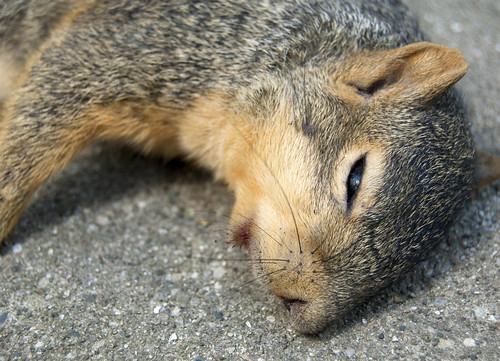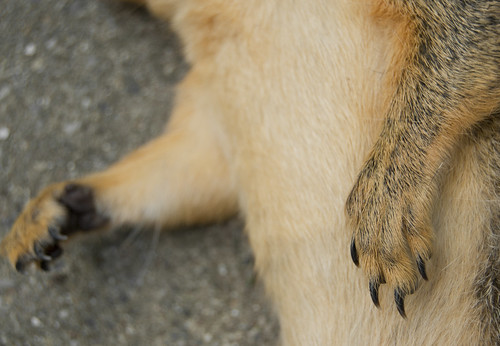I retrieved the squirrel from the road and took it to my parents' backyard, where I would photograph it. I soon found that it was a female, and she seemed to have been in pretty good health before she died. I was surprised by how much she weighed -- I'd estimate at least two pounds, probably more. Even though she'd been hit very recently, she was becoming stiff and smelled of death.

The squirrel's whiskers were very long and pretty. Up-close, I feel that the faces of fox squirrels are strikingly different than those of Marquette's gray squirrels.


Also fascinating to examine are the paws of squirrels. Their feet are very complex, with many paw pads, and the claws are long and sharp, adapted for both digging and climbing. Unlike the feet of a cat or dog -- and very much like the feet of a raccoon -- the paws of a squirrel have no fur on the underside.


After photographing the squirrel with both my Nikon D70 and Nikon F2, I moved her body into a small live trap -- the same trap that we kept April Deer's skull in to finish its decay. For the next couple of months, I plan to observe the body's process of decomposition. Already, flies were inspecting the corpse as I photographed it.
It's interesting to note that as I was writing down my initial observations, a live fox squirrel approached the trap. It was very cautious, and as soon as it sniffed the body, it became very alarmed, flagging its tail and giving the area a very wide berth.
Something else that I'd like to note is a comparison -- and just how much lighting can change the mood, colors, and perceived composition of a photograph (click the image below to enlarge).
 These two photographs were taken only seconds apart, but the first photograph was taken when the sun was covered -- if only slightly -- by clouds. The second photograph was taken in full sunlight. Despite the composition being essentially the same -- the squirrel's position has not changed -- the quality of light has dramatically altered the scene. The first image has a softer, cooler characteristic; the shadows are there, but remain subtle. The second image, on the other hand, is sharper; the colors are more saturated and warm, and the shadows are starker and blacker. I prefer the first image.
These two photographs were taken only seconds apart, but the first photograph was taken when the sun was covered -- if only slightly -- by clouds. The second photograph was taken in full sunlight. Despite the composition being essentially the same -- the squirrel's position has not changed -- the quality of light has dramatically altered the scene. The first image has a softer, cooler characteristic; the shadows are there, but remain subtle. The second image, on the other hand, is sharper; the colors are more saturated and warm, and the shadows are starker and blacker. I prefer the first image.
This afternoon, Steph alerted me that she passed yet another roadkill fox squirrel on our street, only feet away from where I removed this squirrel.
It's interesting to note that as I was writing down my initial observations, a live fox squirrel approached the trap. It was very cautious, and as soon as it sniffed the body, it became very alarmed, flagging its tail and giving the area a very wide berth.
Something else that I'd like to note is a comparison -- and just how much lighting can change the mood, colors, and perceived composition of a photograph (click the image below to enlarge).
 These two photographs were taken only seconds apart, but the first photograph was taken when the sun was covered -- if only slightly -- by clouds. The second photograph was taken in full sunlight. Despite the composition being essentially the same -- the squirrel's position has not changed -- the quality of light has dramatically altered the scene. The first image has a softer, cooler characteristic; the shadows are there, but remain subtle. The second image, on the other hand, is sharper; the colors are more saturated and warm, and the shadows are starker and blacker. I prefer the first image.
These two photographs were taken only seconds apart, but the first photograph was taken when the sun was covered -- if only slightly -- by clouds. The second photograph was taken in full sunlight. Despite the composition being essentially the same -- the squirrel's position has not changed -- the quality of light has dramatically altered the scene. The first image has a softer, cooler characteristic; the shadows are there, but remain subtle. The second image, on the other hand, is sharper; the colors are more saturated and warm, and the shadows are starker and blacker. I prefer the first image.This afternoon, Steph alerted me that she passed yet another roadkill fox squirrel on our street, only feet away from where I removed this squirrel.




Save the squirrels! I wonder how hard it would be to build a speedbump.
ReplyDeleteI would be way to chicken to pick up roadkill off the side of the road.
ReplyDelete